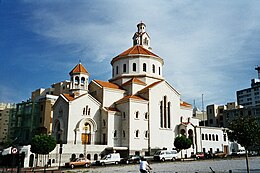



Cathedral of Saint Elias and Saint Gregory the Illuminator in Beirut, the cathedra of the Armenian Catholic Patriarchate of Cilicia. |
|
| Classification | Eastern Catholic |
|---|---|
| Orientation | Eastern Christianity (Armenian) |
| Theology | Armenian Orthodox |
| Polity | Episcopal |
| Pope | Francis |
| Patriarch | Krikor Bedros XX Gabroyan |
| Region | Armenian diaspora |
| Language | Armenian |
| Liturgy | Armenian Rite |
| Headquarters | Cathedral of St Elias and St Gregory the Illuminator, Beirut, Lebanon |
| Founder | Abraham Petros I Ardzivian |
| Origin | 1742 Ottoman Empire (modern Armenia) |
| Members | 150,000 (independent estimates) 757,726 (2017 Annuario Pontificio) |
The 451 Council of Chalcedon caused problems for the Armenian Church which formally broke off communion with the Chalcedonian Churches at the 3rd Synod of Dvin in 610, some Armenian bishops and congregations made attempts to restore communion with the Chalcedonian Churches after the 6th Ecumenical Council of 681. During the Crusades, the Church of the Armenian kingdom of Cilicia entered into a union with the Catholic Church, an attempt that did not last. The union was later re-established during the Council of Florence in 1439, but did not have any real effects for centuries.
Some Armenians converted to Catholicism, and in the absence of any specific Armenian Catholic Church in effect became Latins. In Medieval China, Armenians in China were converted to Catholicism by John of Montecorvino in Beijing and there was also an Armenian Franciscan Catholic community in Quanzhou.
In 1740, Abraham-Pierre I Ardzivian, who had earlier become a Catholic, was elected as the patriarch of Sis. Two years later Pope Benedict XIV formally established the Armenian Catholic Church. In 1749, the Armenian Catholic Church built a convent in Bzoummar, Lebanon. During the Armenian Genocide in 1915–1918 the Church scattered among neighboring countries, mainly Lebanon and Syria.
An Armenian Catholic community was also previously formed by Armenians living in Poland in 1630s the Armenian bishop of Leopolis (see Armenian Catholic Archeparchy of Lviv), Nicholas (Polish: Mikołaj) Torosowicz had entered into union with the Catholic Church. The community which had been historically centered in Galicia as well as in the pre-1939 Polish borderlands in the east, was after World War II expelled to present-day Poland and now has three parishes: in Gdańsk, in Gliwice and in Warsaw.
Go to website